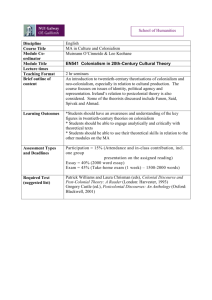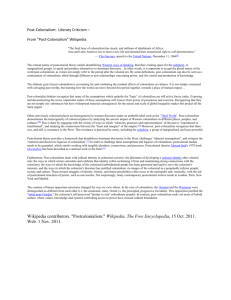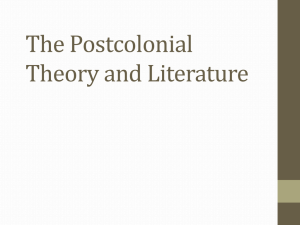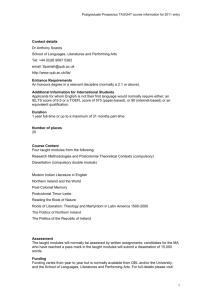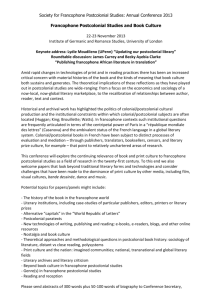Identity Jam and the Postcolonial Predicament
advertisement
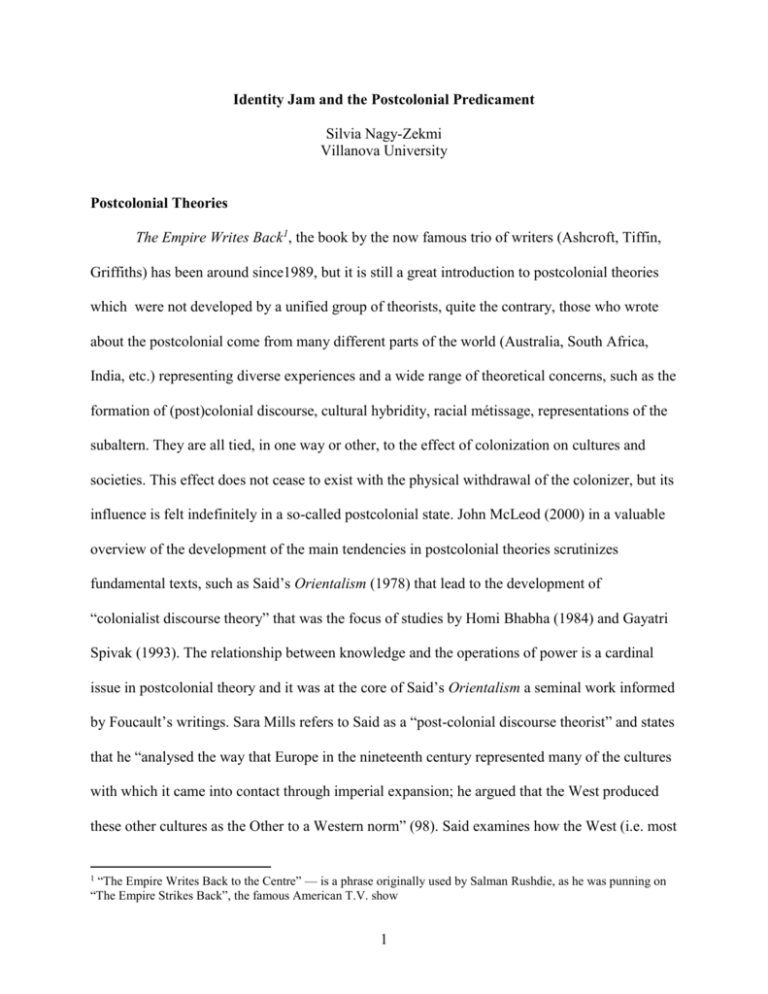
Identity Jam and the Postcolonial Predicament Silvia Nagy-Zekmi Villanova University Postcolonial Theories The Empire Writes Back1, the book by the now famous trio of writers (Ashcroft, Tiffin, Griffiths) has been around since1989, but it is still a great introduction to postcolonial theories which were not developed by a unified group of theorists, quite the contrary, those who wrote about the postcolonial come from many different parts of the world (Australia, South Africa, India, etc.) representing diverse experiences and a wide range of theoretical concerns, such as the formation of (post)colonial discourse, cultural hybridity, racial métissage, representations of the subaltern. They are all tied, in one way or other, to the effect of colonization on cultures and societies. This effect does not cease to exist with the physical withdrawal of the colonizer, but its influence is felt indefinitely in a so-called postcolonial state. John McLeod (2000) in a valuable overview of the development of the main tendencies in postcolonial theories scrutinizes fundamental texts, such as Said’s Orientalism (1978) that lead to the development of “colonialist discourse theory” that was the focus of studies by Homi Bhabha (1984) and Gayatri Spivak (1993). The relationship between knowledge and the operations of power is a cardinal issue in postcolonial theory and it was at the core of Said’s Orientalism a seminal work informed by Foucault’s writings. Sara Mills refers to Said as a “post-colonial discourse theorist” and states that he “analysed the way that Europe in the nineteenth century represented many of the cultures with which it came into contact through imperial expansion; he argued that the West produced these other cultures as the Other to a Western norm” (98). Said examines how the West (i.e. most “The Empire Writes Back to the Centre” — is a phrase originally used by Salman Rushdie, as he was punning on “The Empire Strikes Back”, the famous American T.V. show 1 1 of the colonizing powers) looked at the Orient (i.e. the non-West) attributing all negative features of self to this (Oriental) Other. The West, being the colonizing force, has the control over representation that produces the Other, therefore knowledge of the Orient is constructed based on the knowledge of the Other that the West fabricated through a recycled representation. That is to say that one representation of the Other becomes the justification and basis for the next one. Said argued that knowledge of the Orient could never be innocent, or 'objective', because it was produced by human beings who were necessarily embedded in colonial history and relationships. Such point has also been made, some 20 years before the apparition of Orientalism, albeit less "theoretically", by the Indian nationalist, Bipin Chandra Pal: [W]hen the European scientists study the physical features of our land, when he measures our fields, our altitudes and undulations, investigates our animal, vegetable or mineral kingdom, the records of his study are accepted as true and authoritative. But the study of man belongs altogether to a different plane.... Here also the eye sees, the ear hears, but the real meaning of what is seen or heard is supplied not by the senses, but by the understanding, which interprets what is heard in the light of its own peculiar experiences and associations. (8-9) Said suggested that the Orient is a creation of the West (in a discursive sense), on the other hand, Frantz Fanon had earlier inverted Said’s argument in his indictment of colonialism by saying that Europe was the creation of the Third World (in a physical sense) because its material wealth and labor came from the colonies: “Le bien être et le progrès de l'Europe ont été bâtis avec la sueur et les cadavres de nègres, des Arabes, des Indiens et des Jaunes.” (77) Said concurs with Fanon’s idea by defining a certain “moral geography” for example, in Jane Austin’s Mansfield Park 2 where the writer “sublimates the agonies of Caribbean existence to a mere half dozen passing references to Antigua.” (Said, Culture... 59). It is the slave labor in the plantations of Antigua owned by Sir Tomas that produces the wealth that supports Mansfield Park, the ideal of order and civilization in England whose beauty is accentuated in several passages throughout the novel. Although Said's critique was anticipated by others, it was new in its wide sweeping range and focus, in its invocation of Foucault's ideas about the connections between the production of knowledge and the praxis of power: “forms of knowledge are powerful dominant ideologies that become dominant by displacing or discrediting other forms of knowledge.” However, the great Saidian divide between Europe and the Other – to which Said himself refers to (7) as an ontological and epistemological "style of thought" -- is explored as though it were entirely an effect of the raw discursive power of imperialism. After all, - as Dipesh Chakrabarty notes – “Europe is the only place 'we' know theoretically” (1-26). It is this “hyperreal” Europe of the mind that imposes its style of thought upon a “real outside” of the Other. In other words, theory (Europe as hyper-reality) is designating the means by which the “real” (the Other, the non-Western) is appropriated into thought. Read in this way, one could conclude that regardless of any political intent, Europe could only misrecognize its Other in this formulation, because as Althusser puts it (quoting Spinoza) "the concept of sugar is not sweet." (192) Postcolonial Poetics Regarding postcolonial poetics and representation, the publication of three major works about the colonized and colonizer in the 50's, namely Octave Mannoni’s Prospéro et Caliban. 3 Psychologie de la colonisation (1950), Peau noire, masques blancs (1952) by Fanon, and Memmi’s Portrait du Colonisé précédé de portrait du Colonisateur (1957) put forth the first thorough analysis of the psychology of colonization and its effects on both the colonized and the colonizer emphasizing the antagonistic relationship between them that is thematically present in post-colonial writing. The same binary opposition is emphasized by Abdul JanMohamed thirtysome years later in what he calls a Manichean relationship between colonizer and colonized.2 The early models of postcolonial poetics, originated from the dialectic juxtaposition of the colonizer and colonized as the act of writing is perceived (only) in terms of decolonization, thus reactions to colonial discourse and values are characterized by opposition and by the subversion of their fundamental signifiers. This type of dynamics may also be noticed in the critical evaluations of the encounters of Europeans with different “others” (Todorov, Amodio). Writing is viewed by many critics (Ashcroft, Boehmer, Harlow) as an act of resistance that supposes the existence of a center and margin(s). Therefore, postcolonial poetics oscillates between the two poles of cultural decolonization, abrogation/appropriation3 in which case, the choice and usage of language are key factors. Referring to French debates about postcolonial representation, Alec Hargreaves recognizes that francophonie is a problematic term; he considers it, nevertheless, as a possible uniting factor of diverse cultures (1-3). It seems to be somewhat ironic that post-colonial existence (and aesthetic) should be defined by a uniting element imposed by colonization: the language, whose application itself is in dispute by some postcolonial authors (cf. Glissant, Ngũgĩ). This relationship poses important questions about exactly what decolonization implies 2 In Manichean Aesthetics: The Politics of Literature in Colonial Africa JanMohamed addresses the questions surrounding the representation of both the colonizer and colonized in African colonial narrative by underlining the binary structure of the colonial ideology. 3 Abrogation is the rejection of normative forms of the colonizer’s language as opposed to non-standard and dialectal use in the colonies, and appropriation is the adaptation of the colonizer’s language for postcolonial writing. 4 and how it should be achieved. Some critics (Ngũgĩ wa Thiong'o, Kamau Brathwaite) have stressed the need to recuperate pre-colonial languages and cultures, or to appropriate the languages of the colonizer while abrogating the elitist uses of it. Eloquent examples are Ken Saro Wiwa who wrote his novel, Sozaboy in “rotten english" as opposed to "big big English4 and Ngũgĩ, who – after publishing his influential work, Decolonising the Mind: The Politics of Language in African Literature (1986),5– wrote “Farewell to English” and then decided to write in his native language, Gikuyu6. Sincretist critics argue, though, that because it appropriates the European novel form, a novel even in Bengali or Gikuyu is inevitably a cross-cultural hybrid, and that decolonizing projects must recognize this. distribution? What post-colonial writing (in English, for example) recognizes (and upholds) is that English is no longer the monopoly of the “Englishman” since people residing in the ex-colonies are now the co-owners of the language. Saussure in his Course in General Linguistics (1916) had distinguished between langue and parole, the idealized grammatical form and what goes on in real language interactions. Post-colonial linguists have argued that Saussurian linguistics has marginalized the social by bracketing the message or parole to concentrate on the langue. Ashcroft, for instance, proposes to redress this imbalance by reinstating the parole. As the contest is between margins or the periphery and the centre, it is by the same token between language variants or "the new englishes" and a standard code; the post–colonial discourse in English has thus been labeled a "counter-discourse" which entails writing back with an accent. 4 whose definition he gives as "tedious, erudite arguments or statements in standard English." Aside from Decolonising the Mind, Ngũgĩ has written several works in English: Weep Not, Child, A Grain of Wheat, The River Between, and Petals of Blood, as well as a memoir of the time he spent detained by the Kenyan government-- Detained. Other works include his essays, collected in Homecoming, the short story collection, Secret Lives, and the plays The Black Hermit and The Trial of Dedan Kimathi (with Micere Mugo). 5 Since turning to Gikuyu, Ngũgĩ has written the play I Will Marry When I Want (with Ngũgĩ wa Mirii) and the novels Devil on the Cross and Matagari, but eventually he returned to writing in English as well. 6 5 From “Othering” to “In-Between-ness” Oppositional tendencies were becoming less and less popular in the postcolonial scene because they tend to operate using European models based on mimesis7 and because of their tendency to reduce complex issues to essentialist opposites. But the most important critique against oppositional theorists is that they maintained the dichotomy center/periphery, thus their main reference have ultimately been tied to the hegemonic discourse they were trying to combat. A good example to illustrate this point comes from Alejo Carpentier’s contribution to what later became known (erroneously) as ‘realismo mágico.” In the prologue of El reino de este mundo Carpentier speaks of “lo real maravilloso” that produces authenticity in the representation of the American reality because it is based on a collective belief system. It is true that one of the voices, namely that of Ti Noël represents that perception of the “Other”. However, it must be noted that discourses where the Other is deliberately represented are directed towards an imperial authority and operate from the opposition center/periphery. Spivak calls this phenomenon “othering”. The examination of this question must begin by distinguishing between “other” and “Other.” In Lacan’s theory the “other” designates the other who resembles the self that the child discovers when it looks in the mirror and realizes that s/he is a separate human being. The capital “Other” called by Lacan the grande-outre is in whose gaze the subject gains identity (1968). This “other” is regarded as the repressed part of the psyche, and “Other” as the oppressed groups and individuals. From the point of view of the colonizer, there may be no fundamental difference; from the point of view of the colonized, however, “othering” is to negate their entire experience as humans, by placing an impenetrable separation between the colonizer and the colonized. As It is important to point out the difference between mimesis in the Aristotelian sense and Homi Bhabha’s introduction of the concept of mimicry in colonial representation. 7 6 Hartsock notes, the field of operations of this “archeology” is the site of the ruins of the Enlightenment (35). Thus, it is not surprising that the “other” can be found there only through gaps and absences. The “other” is silent, s/he is spoken for by the colonizer. The need to uncover other sites to find both a living presence and vital alternatives emerged in the postmodern context due to the dissolution of canonical borders that allows for the inclusion of voices that have been previously silenced. Hartsock concludes: “The point is to develop an account of the world which treats our perspectives not as subjugated or disruptive knowledges, but as primary and constitutive of a different world . . . Other possibilities exist and must be (perhaps can only be) developed by hitherto marginalized voices” (36). In her discussion of alterity Spivak suggests that the otherness is constructed through imperial discourse of power. Following Lacan, she also distinguishes between the other and the Other (although their definitions differ slightly) and suggests that they were created together in a reciprocal relationship. In The Post-Colonial Critic, Spivak concludes: “Europe has consolidated itself as sovereign subject by defining its colonies as ‘Others’, even as it constituted them, for purposes of administration and expansion of markets into programmed near-images of that very sovereign self “ (99). Placing emphasis on this “sovereign self” Stuart Hall8 distinguishes three kinds of “otherness” 1. self-othering (where the other is constructed as different within Western categories of knowledge; moreover, s/he is subjected to this knowledge); 2. creolization or racial mixture, two oppositional “vectors” (395) that operate simultaneously: that of similarity and continuity and that of difference and rupture; 3. otherness in metropolitan centers: that is, the difference is “inscribed” in cultural identity (394-396). 8 Discussing Caribbean identity formation Hall recognizes two kinds of identities: 1. being (oneness), 2. becoming (discontinuity). He uses Derrida’s concept of “différance” to support his postulate. 7 Hybridism, Heterogeneity, ‘Third Space’ Around the early 90's a transition took place in postcolonial studies. Theorists seemed to be distancing themselves from the binary mode and proposed concepts like “hybridism”, “métissage”, and “heterogeneity, a “third space” of enunciation (Bhabha, Moreiras) a hybrid, ambivalent space of signifiers emerges as a “contact-zone”(Mary Louise Pratt) between the colonizer and the colonized. Just as Derrida adds a third term, a temporal dimension to the Saussurean sign, so Homi Bhabha constructs a third space, an in-between locus of meaning between the indigenous and the European allowing neither of them a separate cultural or discursive continuity. For example’s sake I mention the Latin American precedents to the notions about hybridity that may be traced back to Fernando de Ortiz’ coining of ‘transculturación’,9 one of the first attempts to go beyond the binary models in theorizing about the hegemonic imposition of and resistance to cultural change that includes the elements of mutual influence and fluidity. The importance of transculturation (the term) is explained by Moreiras (264-65) as a phenomenon that arises due to the coincidence of its conception with the emergence of the national-popular state in Latin America at the time, culminating in Angel Rama’s work about narrative transculturation that provides an explanation based on this ambivalent space of enunciation that comes close to being Bhabha’s “third space”. The quest for an idea that expresses this inbetween space of enunciation that would be able to circumvent the stalemate of binary oppositions would resurface in the concept of heterogeneity developed by Antonio Cornejo Polar. Heterogeneity is embodied in the resistance to the homogenizing forces of colonialism, and to the equally Eurocentric ideologies of the nation-state. 9 The term first appeared in Fernando de Ortiz’s Contrapunteo cubano del tabaco y el azúcar (1940). 8 Postcolonial Identity To sum up: Postcolonial societies inherit the trauma of colonialism that subjects people to a cultural displacement. Homi Bhabha connects the idea of cultural; displacement to the broader issue of cultural and national identity (145). Thus the nation becomes “a liminal signifying space that is internally marked by the discourses of minorities, the heterogeneous histories of contending peoples, antagonistic authorities and tense location of cultural difference” (148). Postcolonial identity is to be included in the discussion of the “discourses of minorities” as it also contributes to the formation “the heterogeneous histories”. The fragmented or hybrid nature of the postcolonial subject demands its construction through subversion of the colonial discourse. These “deconstructive moves” within the texts are used to dismantle master narratives inspired by Eurocentric discourse and, at the same time, to challenge the logocentric categories upon which colonial discourses are based. The postcolonial subject that dwells in the (once) colonized space characterized by modernity is to be positioned on the very boundary of modernity, at the same time within and outside of the hegemonic culture. As Shaobo Xie points out, “the hegemonic discourse of modernity tends to subjugate all its subjects to its historicist syntax of narrative, molding their consciousness, structuring their feelings and sensory data accordingly. However, the subject of cultural revision, postcolonial and counterhegemonic in nature, threatens to subvert the hierarchical syntax of modernity” (18-19). Bhabha’s theory of postcolonial counter-hegemony with its revisionist strategy opens up new spaces of re-inscription and negotiation not only for resistance to present forms of imperialism, but it goes a long way toward interrogating and disintegrating any form of imperialism. As Said suggests, imperialism is “a word and an idea today is so controversial, so 9 fraught with all sorts of questions, doubts, polemics and ideological premises as nearly to resist use altogether” (Culture... 3). However, even if centuries of expansionary capitalism were accepted from a global perspective within which colonialism and postcolonialism are phases, that does not exhaust the debates about postcolonialism and its historical context. In her much quoted “Notes of the Post-Colonial” Ella Shohat asks: “When exactly the postcolonial begin?” (103), the historian, Arif Dirlik “misreading the question deliberately” gives an answer that is “only partly tongue in cheek: “When Third World intellectuals have arrived in First World academe” (52) referring, perhaps to the parts of the world where the term post-colonial may not be appropriate. How to place the label ‘post’ onto a state which is not yet fully present and linking it to something which has not fully disappeared, but in many ways this paradoxical inbetween-ness is precisely what characterizes the postcolonial world that is neither post- nor pastas Spivak suggests: “We live in a post-colonial neo-colonized world” (The Post-Colonial Critic 166). Works Cited: Althusser, Louis. Essays in Self-Criticism. Trans. Grahame Lock. London: NLB, 1976. Amodio, Emanuele. Formas de la alteridad. Quito: Ediciones Abya Yala, 1993. Ashcroft, Bill, Gareth Griffiths and Helen Tiffin. The Empire Writes Back. Londres: Routledge, 1989. Austin Jane Mansfield Park. NY: Alfred Knopp, 1992. Carpentier, Alejo. “Prólogo.” El reino de este mundo. (1949) Obras completas Vol. II. México: Siglo XXI, 1983. Boehmer, Elleke. Colonial and Postcolonial Literature. Oxford: Oxford University Press, 1995.Brathwaite Kamau. Middle Passages. New York: New Directions, 1993. 10 Chakrabarty, Dipesh. . “Postcoloniality and the Artifice of History: Who Speaks for ‘Indian’ Pasts?” Representations, Winter 1992: 1-26. Cornejo Polar, Antonio. “Mestizaje, transculturación, heterogeneidad.” Revista de Crítica Literaria, XX, 40 1994: 368-371. Bhabha, Homi. The Location of Culture. Londres: Routledge, 1994. - - -. “The Third Space.” Rutherford, Jonathan ed. Identity: Community, Culture, Difference. London: Lawrence & Wishart, 1990. - - -. “The Other Question.” Mongia, Padmini, ed. Contemporary Postcolonial Theory. A Reader. New York: Arnold Books, 1997: 37-54. Derrida, Jacques. Monolingualism of the Other or, The Prosthesis of Origin. Transl. Patrick Mensah Stanford UP, 1998. Dirlik, Arif. “The Post-Colonial Aura: Third World Criticism in the Age of Global Capitalism.” Critical Inquiry 20 Winter (1994): 329-342. Fanon, Frantz. Peau noire, masques blancs. Paris: Eds. du Seuil, 1952. Foucault, Michel. Microfísica del poder. Madrid: La Piqueta. 1980. - - -. La arqueología del saber. (1970) México: Siglo XXI, 1995. Glissant, Edouard. Le discours antillais. Paris :Seuil, 1981. Hall, Stuart. Questions of Cultural Identity. Sage Publications, 1996 Hargreaves, Alec G. Post-Colonial Cultures in France. London: Routledge, 1997. Harlow, Barbara. Resistance Literature. New York: Methuen, 1987. Hartsock Nancy. (1990) “Foucault on Power: A Theory for Women?” IN: Linda Nicholson, (Ed.) Feminism/Postmodernism. (New York, Routledge) pp. 32-44. 11 JanMohamed, Abdul. Manichean Aesthetics: The Politics of Literature in Colonial Africa. Amherst: Umass UP, 1983. Lacan, Jacques. Cahiers de lectures freudiennes. Paris : Lysimaque, 1996 Levinson, Brett. The Ends of Literature. Stanford: Stanford University Press, 2001 Mannoni, Octave. Prospero and Caliban: The Psychology of Colonization. Ann Arbor: Ann Arbor Paperbacks, 1990. Memmi, Albert. Portrait du Colonisé précédé de portrait du Colonisateur. Paris : Buchet/Chastel, 1957. McLeod, John. (2000) Beginning Postcolonialism. (Manchester, Manchester University, Press) Mills, Sara. (1998) “Post-colonial Feminist Theory.” Stevi Jackson and Jackie Jones, eds. Contemporary Feminist Theories. (New York, New York University Press) pp. 98-112. Moreiras, Alberto. The Exhaustion of Difference. Durham: Duke UP, 2001. Moreiras, Alberto. Tercer espacio: Literatura y duelo en América Latina. Santiago de Chile: LOM, 1999. Ngugi wa Thoing’o. “Farewell to English” The Post-Colonial Studies Reader. Eds. Ashcroft, Griffiths, Tiffin. London: Routelgde, 1995: 438-442. - - -. Decolonising the Mind. The Politics of Language in African Literature. NY: Heineman, 1986. Ortiz, Fernando de. Contrapunteo cubano del tabaco y el azúcar, Cátedra, 2002. Pal, Bipin Chandra The Soul of India: A Constructive Study of Indian Thoughts and Ideals. Calcutta: Yugayatri Prakashak, 1958. Pratt, Mary Louise. “Arts of the Contact Zone” Profession 91, Modern Language Association, (1991): 33-40. 12 Rama, Angel. Transculturación narrativa en Amérca Latina, México, Siglo XXI, 1982 Said, Edward. Orientalism. New York: Vintage Books, 1978. - - -. Culture and Imperialism. New York: Vintage Books, 1994. Saro Wiwa, Ken. Sozaboy 1986. Saussure, Ferdinand de. Course in General Linguistics Shohat, Ella. “Notes on the Post-Colonial.” Contemporary Postcolonial Theory. Ed. Padmini Mongia. Nueva York: Arnold, 1997: 322-334. Spivak, Gayatri Chakravorty. “Can the Subaltern Speak?” Colonial Discourse and Postcolonial Theory. Editores: Patrick Williams, Laura Crisman. Nueva York: Columbia University Press, 1994: 66-111. - - -. “Who Claims Alterity?” Art in theory 1900-1990. An anthology of changing ideas. Ed. Charles Harrison y Paul Wood. Oxford: Blackwell,, 1992: 1119-1124. - - -. The Post-Colonial Critic: Interviews, Strategies, Dialogues. Ed. Sarah Harasym. London: Routledge, 1990 Todorov, Tzvetan. La conquista de América. El problema del otro. México: Siglo XXI Editores, 1987. Xie Shaobo “Rethinking the Problem of Post-Colonialism.” New Literary History. 28.1 (1997): 7-9 13
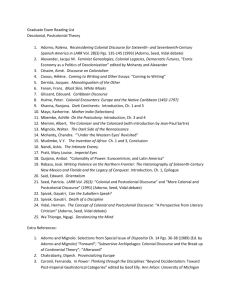
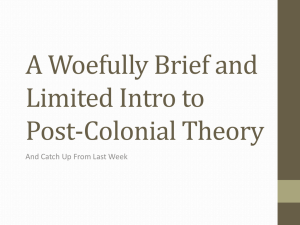
![Reading Post-colonial Texts [DOCX 24.68KB]](http://s3.studylib.net/store/data/006751790_1-888963e6911f3dd4b7d9c1a137619c0f-300x300.png)
